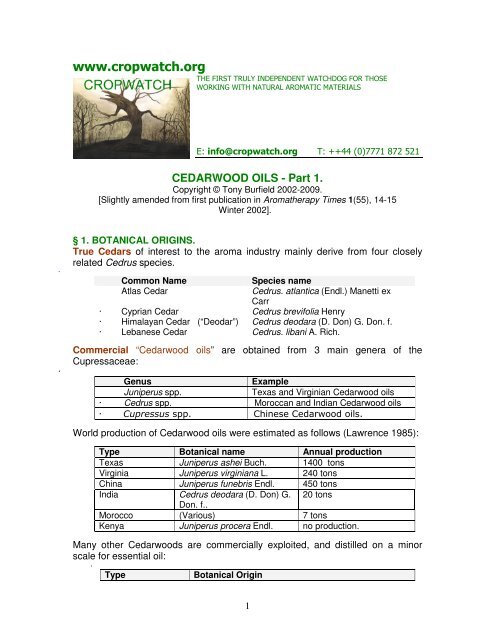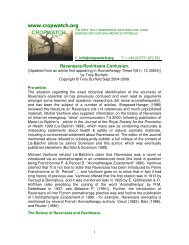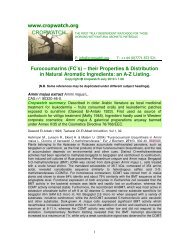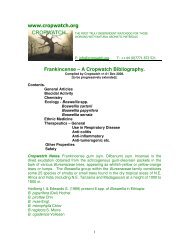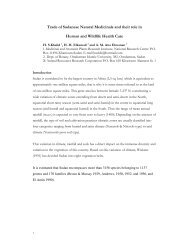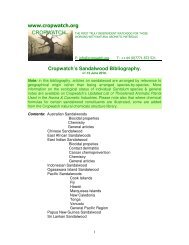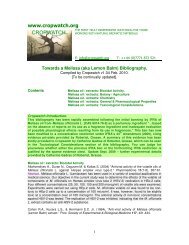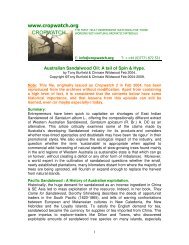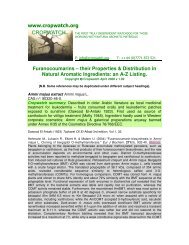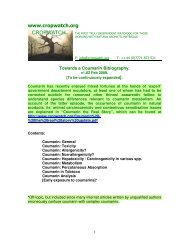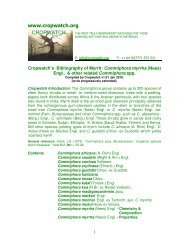CEDARWOOD OILS - Cropwatch
CEDARWOOD OILS - Cropwatch
CEDARWOOD OILS - Cropwatch
Create successful ePaper yourself
Turn your PDF publications into a flip-book with our unique Google optimized e-Paper software.
www.cropwatch.org<br />
THE FIRST TRULY INDEPENDENT WATCHDOG FOR THOSE<br />
WORKING WITH NATURAL AROMATIC MATERIALS<br />
E: info@cropwatch.org T: ++44 (0)7771 872 521<br />
<strong>CEDARWOOD</strong> <strong>OILS</strong> - Part 1.<br />
Copyright © Tony Burfield 2002-2009.<br />
[Slightly amended from first publication in Aromatherapy Times 1(55), 14-15<br />
Winter 2002].<br />
·<br />
·<br />
§ 1. BOTANICAL ORIGINS.<br />
True Cedars of interest to the aroma industry mainly derive from four closely<br />
related Cedrus species.<br />
Common Name<br />
Atlas Cedar<br />
Species name<br />
Cedrus. atlantica (Endl.) Manetti ex<br />
Carr<br />
· Cyprian Cedar Cedrus brevifolia Henry<br />
· Himalayan Cedar (“Deodar”) Cedrus deodara (D. Don) G. Don. f.<br />
· Lebanese Cedar Cedrus. libani A. Rich.<br />
Commercial “Cedarwood oils” are obtained from 3 main genera of the<br />
Cupressaceae:<br />
Genus<br />
Example<br />
Juniperus spp.<br />
Texas and Virginian Cedarwood oils<br />
· Cedrus spp. Moroccan and Indian Cedarwood oils<br />
· Cupressus spp. Chinese Cedarwood oils.<br />
World production of Cedarwood oils were estimated as follows (Lawrence 1985):<br />
Type Botanical name Annual production<br />
Texas Juniperus ashei Buch. 1400 tons<br />
Virginia Juniperus virginiana L. 240 tons<br />
China Juniperus funebris Endl. 450 tons<br />
India Cedrus deodara (D. Don) G. 20 tons<br />
Don. f..<br />
Morocco (Various) 7 tons<br />
Kenya Juniperus procera Endl. no production.<br />
Many other Cedarwoods are commercially exploited, and distilled on a minor<br />
scale for essential oil:<br />
·<br />
Type<br />
Botanical Origin<br />
1
Mulanje cedarwood<br />
Port Oxford or<br />
Oregon Cedarwood<br />
Weeping Blue<br />
Juniper<br />
Hibawood<br />
Widdrington whytei Rendle<br />
syn. W. nodiflora (L.) Powrie<br />
Chamaecyparis lawsoniana<br />
Juniperus recurva Buch.-Ham.<br />
Thujopsis dolabrata (L.f.) Siebold & Zucc<br />
Hibawood oil was formerly used as a perfumery ingredient.<br />
§2. ECOLOGICAL STATUS OF <strong>CEDARWOOD</strong> ATLAS AND <strong>CEDARWOOD</strong><br />
HIMALAYAN.<br />
(a) Cedarwood oil Atlas is produced by steam distillation of the waste wood, or<br />
sawdust of the tree, which can grow to 65m. at an<br />
elevation of 1400-2500m. in on several types of soil in<br />
133,653 hectares of Cedar forest (Mardaga 1999) in the<br />
Moroccan Middle Atlas, Rif central and Grand Atlas<br />
Oriental and Middle Atlas oriental. It has been<br />
estimated that Cedar forest might which constitute 2.8%<br />
of the total area of Moroccan forest. The tree also<br />
grows in N.W. Algeria, and has been imported into N.<br />
America & Canada. The tree has been important in the<br />
socio-economy of Morocco, being good for furniture<br />
making. Whilst Cedarwood atlas trees are well<br />
conserved in specific area of parkland, the ecosystem<br />
is very fragile - often the margins are subject to<br />
degradation by erosion, demineralisation, dehydration,<br />
desertification etc. resulting in areas of complete<br />
desolation. From what I have seen there this year, the<br />
Moroccan ministry of Agriculture and various other<br />
bodies are doing all they can in very difficult circumstances to conserve the rich<br />
biodiversity of plants in Morocco.<br />
(b) Cedarwood Himalayan.<br />
Cedarwood oil Himalayan is produced by steam distillation of the chipped wood<br />
of a tree which can reach 50m. is produced by steam distillation of the fragrant<br />
wood, saw dust, shavings and stumps of the tall evergreen tree which grows on<br />
the Himalayan slopes of N. India, Afghanistan and Pakistan, at elevations<br />
between 1650-2400m.<br />
As early as 1958, Chowdhury & Gosh noted that the three most plentiful timbers<br />
in India were Tectona grandis, Shorea robusta and Cedrus deodara. Cedrus<br />
deodara is been extensively used for external structures (not for internal work; it<br />
is too knotty and will not take paint), and is the wood of choice for railway<br />
sleepers. Its very usefulness has lead to its over-exploitation. The oil has<br />
plummeted in production volume from 20 tons/annum in the 1970’s, to about a<br />
ton/annum presently.<br />
2
§3. <strong>CEDARWOOD</strong> <strong>OILS</strong>: CHEMISTRY AND ODOUR EVALUATION.<br />
1. Cedrus atlantica (Endl.) Manetti ex Carr.<br />
Odour: It is a yellow-brown to brown oil with dirty-woody, resinous, urinous<br />
odour. The dry-down on a perfumers strip is still woody-dirty, and takes on an<br />
almost Plasticine impression. It is very persistent.<br />
Chemistry: Essential oil is mainly composed of sesquiterpene hydrocarbons α-<br />
himalchene, β-himalchene, and γ-himalchene which together can make up<br />
almost 70% of the composition<br />
The oil also contains a number of α- and γ-atlantone isomers, especially (E)-(+)-<br />
α-atlantone, which can constitute 10-15% in total of the oil (α- & γ-atlantone are<br />
sweet smelling woody odourants and especially contribute towards the odour of<br />
the oil).<br />
GC Analysis (TB unpublished data):<br />
α-pinene tr., γ-himachalene 10.87%, β-himachalene 54.00%, α-himachalene<br />
17.22%, δ-cadinene 1.48%, α-humulene, 0.54%, β-calcorene, 0.74%, cedrene<br />
epoxide () 0.45%, β-himachalene oxide 0.34%, α-cedrene 0.49%, (E-)-αatlantone<br />
1.41%, γ-atlantone 1.69%.<br />
The oil is widely used for insect repellent activities; Turkish carpet shops are<br />
walled with cedarwood boards to deter moths. Cedarwood oil Atlas is used in<br />
local ethnobotanical medicine for a wide variety of purposes.<br />
2. Cedrus deodara (D. Don) G. Don. f. .<br />
3
Odour: The oil is yellow-brown to reddish brown, slightly viscous oil with an<br />
odour that is slightly dirty, somewhat crude and woody, and also sweet resinous.<br />
It is lighter than Cedarwood oil Atlas, somewhat urinic, with a limonene/citrus<br />
aspect. There is also sometimes a hint of a cassis-like note. The dry-down is dirty<br />
woody with an almost cresylic character - almost narcissus-like.<br />
Chemistry: Older literature suggests that the characteristic odour of C. deodora<br />
is due to the presence of p-methyl-δ-3- tetrahydroacetophenone, but the oil also<br />
contains p-methyl acetophenone, cis- and trans- atlantones, α- and β-<br />
himalchenes, ar-dihydroturmerone as well as (+)-himachalol and (+)-<br />
allohimachalol, amongst others. The oil sold to aromatheraists is usually rectified<br />
– the unrectified oil is dirtier and more crudely resinous and urinic, also<br />
possessing a slight cassis note.<br />
The oil itself finds use in Ayurvedic medicine, as an anti-helmintic; decoctions of<br />
the wood being considered diaphoretic, diuretic and carminative. The bark is<br />
astringent and used for fevers, diarrhea and dysentry and the oleoresin and oil of<br />
the wood are used for treatment of ulcers and skin diseases.<br />
§4. OTHER <strong>CEDARWOOD</strong> <strong>OILS</strong>.<br />
(a) Cedarwood oil Chinese Cupressus funebris (Endl.) Franco<br />
Produced by steam distillation of the wood of Chinese Weeping Cypress, which<br />
is an evergreen shrub growing in Kweichow and Shaansi, Guizhou, Kansu, and<br />
Szechwan provinces. The oil and wood are also used to prepare incense in<br />
China. Annual output in China was given as 1000-1500 tons Zhaobang (1995).<br />
Burfield (2002) gives the analysis as: α -cedrene 27.1%, β-cedrene 8.8%,<br />
thujopsene 30.0%, α-himalchene 0.5%,β-himalchene 0.5%, ar-curcmene 0.4%,<br />
α-selinene 3.0%, cuparene 3.3%,cedrol 12.0%, widdrol 4.9%, methyl carvacrol<br />
0.6%<br />
4
The oil from C. funebris is pale yellow or yellow-green, with an odour that is<br />
almost invariably smoky, woody, bordering on crude, with an almost cresylic<br />
character. In comparison cedarwood oil Virginian appears smooth woody, slightly<br />
oily pencil sharpenings, and somewhat slightly sweet in comparison. The<br />
Chinese oil is, however, more powerful. The USA and Europe import large<br />
quantities of the Chinese oil - as it is a quarter of the price of Texan and Virginian<br />
Cedarwood oils, it is widely used as an adulterant of these oils.<br />
(b) Cedarwood oil Texas Juniperus ashei Buch.<br />
Texas/Mexican cedarwood oil essential oil is produced by steam distillation of the<br />
wood or wood shavings of the small tree, which grows in Texas, Mexico and<br />
parts of Central America. Cedarwood oil sold for under $4 per kilo in the nineties<br />
– it has always been cheap so there was little profit in harvesting Cedarwood<br />
trees, and millions of acres of farmland became invaded by this opportunist<br />
species. The US government offered incentives to clear this land, so that wood to<br />
produce the oil is in adequate supply. New technology (continual distillation<br />
termed “steam stripping” used by Texarome Inc. of Texas) replaces the older<br />
steam distillation process, which used to take up the 8 hours to remove the<br />
essential oil. G. R. Boucard and R.W. Serth “Practical Design of a continuous<br />
distillation plant for the separation of aromatic raw materials” can be viewed on<br />
http://207.71.36.16/distil.htm.<br />
The odour profile of the oil is of intense pencil sharpenings, smoky, woody notes<br />
with aspects of guaiacwood, but much drier than other Cedarwood oils. Drydown<br />
is woody, smoky, and dry. Cedarwood oil Texas contains α-cedrene, β-<br />
cedrene, thujopsene, widdrol, pseudo-cedrol, β-chamigrene, cedrol, widdrene,<br />
isowiddrene, α-chamigrene and three cuparene isomers.<br />
(c) Phoenician Juniper Juniperus phoenicea. L.<br />
Distilled from wood of shrub, or small conical tree distributed throughout<br />
Mediterranean, and N. Africa and Canary Islands and which grows to 17m. Entire<br />
forests of J. phoenicea, growing to 2000 m. can be found in Algeria. In Morocco<br />
J. phoenicea f. megalocarpa Maire in also found on the E. coastal parts of<br />
Morocco. J. phoenicea var. turbinata Parlatore with egg-shaped seeds has also<br />
been described as growing in Algeria, Spain, Italy and Sicily.<br />
The odour of the Lebanese oil is pine-like with some turpentine elements, almost<br />
cineolic; very toppy; oily; underneath some leathery warm labdanum character.<br />
Dry-down is powerful amber, labdanum-like, resinous. It has been noted by the<br />
author the amber note intensity is seasonal.<br />
Lawrence (1987/1988) reports on the terpene hydrocarbon composition of J.<br />
phoenicea giving the main component as α-pinene as 70.4% followed by<br />
limonene and β-phellandrene at 8.3% [ref Lawrence B.M. Perf & Flav Dec<br />
1987/Jan 1988 p60]. R.P.Adams et al. (1991) compared the leaf oils of J.<br />
phoenicea, J phoenicea subsp. eu-meditrerranea and J. phoenicea var. turbinata<br />
(Guss.) Parl. They discovered that all oils were α-pinene dominant but J.<br />
5
phoenicea contained moderate amounts of myrcene, limonene, β-phellandrene,<br />
α-terpinyl acetate and 1-epi-cubenol.<br />
(d) Droopping Juniper Juniperus recurva Buch. ex D. Don.<br />
Small tree of conical habit, with stringy shaggy bark and drooping branches. Of<br />
interest as the wood and sawdust of this spp. and especially var coxii is burnt as<br />
incense, and set out in open vessels scenting the air with a cedarwood-like<br />
fragrance in Buddhist temples in the E. Himalaya.<br />
(e) Cedarwood oil Virginian Juniperus virginiana L.<br />
Virginian cedarwood oil is the volatile essential oil produced by the steam<br />
distillation of the chopped wood, stumps, logs, wood shavings or sawdust of the<br />
slow-growing Eastern Red Cedar, growing in the S.E. of USA, Canada and<br />
Japan. The oil is yellow to yellow-brown (sometimes red-brown), often solid or<br />
semi-solid at room temperature due to precipitated cedrol. Redistilled oils, where<br />
sold, are almost colourless. The oil has a woody, oily, somewhat dry odour but<br />
cleaner, and markedly smoother than Atlas or Himalayan oils although less<br />
powerful. There is a distinct pencil-sharpenings note. Dry-down is still smooth<br />
woody-oily, retaining the ‘pencil-sharpenings’ aspect.<br />
Virginia cedarwood is considered by many perfumers to have a smoother and<br />
finer (but less powerful) odour than Texas oil. The major odour impact compound<br />
of cedarwood oils is considered to be (+)-α-cedrol, which occurs at up to 15% in<br />
the oil; the major portion of the oil being composed α- and β-cedrenes and<br />
thujopsene which are weak woody odourants. The sesquiterpene hydrocarbon<br />
content is 55 and 65%. Cedarwood oil Virginia shows a higher cedrol content<br />
than the Texas oil, and higher β-caryophyllene and γ-eudesmol, whereas<br />
Chinese oils show higher thujopsene contents. Cedarwood oil Virginia is<br />
additionally used in insecticides, polishes and cleaning products, soaps,<br />
liniments, and cedarwood still-residues have been used in the manufacture of<br />
linoleum.<br />
§5. COMMENTS.<br />
Although there are some similarities in the major chemical constituents of Cedrus<br />
atlantica and Cedrus deodara, there is little similarity between the latter oils and<br />
Cupressus funebris, Juniperus ashei or Juniperus virginiana etc. Any therapeutic<br />
properties that Cedrus atlantica and Cedrus deodara might possess therefore,<br />
would not necessarily be mimicked by the other oils. It is hoped that this might be<br />
explored further in a future article.<br />
References:<br />
Abdelmalek Benabid (2000) Flore et écosystèmes du Maroc – Evaluation et preservation<br />
de la biodiversité pub. Editions Ibis Press Paris 2000.<br />
Adams R.P (1991). “Cedar Wood Oil – Analysis and Properties” in Modern Methods of<br />
Plant Analysis New Series Vol 12 Essential Oils and Waxes ed. H.F. Linskens and J.F.<br />
Jackson pub. Springer-Verlag NY p159-173<br />
6
Burfield T (2000) Natural Aromatic Materials – Odours and Origins pub. Atlantic Institute<br />
of Aromatherapy, Tampa 2000.<br />
Burfield T (2002) "Odour Profiling (of Essential Oils) and Subjectivity" - talk given at the<br />
RQA's 12th Annual Conference Saturday, 9th March 2002 Regent's College Conference<br />
Centre, London.<br />
Chowdhury KA and Gosh S (1958) Indian Woods, their identification properties and uses<br />
Vol 1, Manager of Publicns, Delhi.<br />
Mardaga (1999) Le grand livre de la Foret Morocaine pub. P. Amardaga Spimont<br />
(Belgium) 1999.<br />
Zhaobang S. (1995) CIFOR Occasional paper No 6 “Production and Standards for<br />
Chemical Non-Wood Forest Products in China” CFIOR Sindangbarang, Bogor,<br />
Indonesia.<br />
<strong>CEDARWOOD</strong> <strong>OILS</strong> – Part 2.<br />
Copyright © Tony Burfield 2003-2009.<br />
[Slightly amended from its first appearance in Aromatherapy Times 1(56),14-16<br />
Spring 2003].<br />
§6. OTHER <strong>CEDARWOOD</strong> <strong>OILS</strong><br />
(a) Cedarwood oil Chinese Cupressus funebris (Endl.) Franco.<br />
Although maybe slightly more unfamiliar to aromatherapists, importantly, the<br />
USA and Europe import large quantities of this oil, and, since it is a quarter of the<br />
price of Texan and Virginian Cedarwood oils, it is widely used as an adulterant of<br />
these oils. Although C. funebris is the stated botanical source of the Cedarwood<br />
oil Chinese, it is believed that in practice oils from other trees are frequently<br />
substituted in this commercial product. e.g. from Juniperus chinensis.<br />
The oil itself is produced by steam distillation of the wood of Chinese Weeping<br />
Cypress, which is an evergreen shrub growing in Kweichow and Shaansi,<br />
Guizhou, Kansu, and Szechwan provinces. The oil and wood are also used to<br />
prepare incense in China. Annual output in China was given as 1000-1500 tons<br />
by Zhaobang (1995). Burfield (2002) gives the analysis as: α-cedrene 27.1%, β-<br />
cedrene 8.8%, thujopsene 30.0%, α-himalchene 0.5%,β-himalchene 0.5%, arcurcmene<br />
0.4%, α-selinene 3.0%, cuparene 3.3%, cedrol 12.0%, widdrol 4.9%,<br />
methyl carvacrol 0.6%<br />
7
The oil from C. funebris is pale yellow or yellow-green, with an odour that is<br />
almost invariably smoky, woody, bordering on crude, with an almost cresylic<br />
character. In comparison Cedarwood oil Virginian appears smooth woody,<br />
slightly oily pencil sharpenings, and somewhat slightly sweet in comparison. The<br />
Chinese oil is, however, more powerful.<br />
(b) Cedarwood oil Texas Juniperus ashei Buch.<br />
Texas/Mexican cedarwood oil essential oil is produced by steam distillation of the<br />
wood or wood shavings of this small tree, which grows in Texas, Mexico and<br />
parts of Central America. Cedarwood oil Texas was sold for under $4 per kilo in<br />
the nineties – it has always been cheap so there was little profit in harvesting<br />
Cedarwood trees, and millions of acres of farmland became invaded by this<br />
opportunist species. The US government offered incentives to clear this land, so<br />
that wood to produce the oil is in adequate supply. Now new technology (in the<br />
form of continual distillation termed “steam stripping” (as used by Texarome Inc.<br />
of Texas) replaces the older steam distillation process, which used to take up the<br />
8 hours to remove the essential oil. A description of the process by G. R.<br />
Boucard and R.W. Serth “Practical Design of a continuous distillation plant for the<br />
separation of aromatic raw materials” could be viewed on<br />
http://207.71.36.16/distil.htm.<br />
The odour profile of the oil is of intense pencil sharpenings, smoky, woody notes<br />
with aspects of guaiacwood, but much drier than other Cedarwood oils. Drydown<br />
is woody, smoky, and dry. Cedarwood oil Texas contains α-cedrene, β-<br />
cedrene, thujopsene, widdrol, pseudo-cedrol, β-chamigrene, cedrol, widdrene,<br />
isowiddrene, α-chamigrene and three cuparene isomers.<br />
(c) Phoenician Juniper Juniperus phoenicea. L.<br />
Distilled from wood of shrub, or small conical tree distributed throughout<br />
Mediterranean, and N. Africa and Canary Islands and which grows to 17m. Entire<br />
forests of J. phoenicea, growing to 2000 m. can be found in Algeria. In Morocco<br />
J. phoenicea f. megalocarpa Maire in also found on the E. coastal parts of<br />
Morocco. J. phoenicea var. turbinata Parlatore with egg-shaped seeds has also<br />
been described as growing in Algeria, Spain, Italy and Sicily.<br />
The odour of the Lebanese oil is pine-like with some turpentine elements, almost<br />
cineolic; very toppy; oily; underneath some leathery warm labdanum character.<br />
Dry-down is powerful amber, labdanum-like, resinous. It has been noted by the<br />
author the intensity of the amber note appears to be seasonally related.<br />
Lawrence (1987) reports on the terpene hydrocarbon composition of J.<br />
phoenicea, giving the main component as α-pinene at 70.4% followed by<br />
limonene and β-phellandrene at 8.3%. R.P.Adams et al. (1991) compared the<br />
leaf oils of J. phoenicea, J phoenicea subsp. eu-meditrerranea and J. phoenicea<br />
var. turbinata (Guss.) Parl. They discovered that all oils were α-pinene dominant<br />
but J. phoenicea contained moderate amounts of myrcene, limonene, β-<br />
phellandrene, α-terpinyl acetate and 1-epi-cubenol. The authors experience is<br />
8
that α-pinene and δ-3-carene constitute >85% of traded oils seen, with smaller<br />
additional amounts of myrcene, terpinolene and α-terpinyl acetate also present.<br />
(d) Drooping Juniper Juniperus recurva Buch. ex D. Don.<br />
A small tree or shrub of conical habit, with stringy shaggy bark and drooping<br />
branches. The species is of interest as the wood and sawdust, especially that<br />
from J. recurva var coxii and J. recurva var. squatama Parl. (Weeping Blue<br />
Juniper) is burnt as incense, and set out in open vessels scenting the air with a<br />
cedarwood-like fragrance in Buddhist temples in the E. Himalaya. The<br />
photographs illustrate scenes where the author has experienced these wonderful<br />
scented odours.<br />
(e) Cedarwood oil Virginian Juniperus virginiana L.<br />
Virginian cedarwood oil is the volatile essential oil produced by the steam<br />
distillation of the chopped wood, stumps, logs, wood shavings or sawdust of the<br />
slow-growing Eastern Red Cedar, growing in the S.E. of USA, Canada and<br />
Japan. The oil is yellow to yellow-brown (sometimes red-brown), often solid or<br />
semi-solid at room temperature due to precipitated cedrol. Redistilled oils, where<br />
sold, are almost colourless. The oil has a woody, oily, somewhat dry odour but<br />
cleaner, and markedly smoother than Atlas or Himalayan oils although less<br />
powerful. There is a distinct pencil-sharpenings note. Dry-down is still smooth<br />
woody-oily, retaining the pencil-sharpenings aspect.<br />
Virginia cedarwood is considered by many perfumers to have a smoother and<br />
finer (but less powerful) odour than Texas oil. The major odour impact compound<br />
of cedarwood oils is considered to be (+)-α-cedrol, which occurs at up to 15% in<br />
the oil; the major portion of the oil being composed α- and β-cedrenes and<br />
thujopsene which are weak woody odourants. The sesquiterpene hydrocarbon<br />
9
content is between 55-65%. Cedarwood oil Virginia shows a higher cedrol<br />
content than the Texas oil, and higher β-caryophyllene and γ-eudesmol, whereas<br />
Chinese oils show higher thujopsene contents. Cedarwood oil Virginia is<br />
additionally used in insecticides, polishes and cleaning products, soaps,<br />
linaments, and cedarwood still residues have been used in the manufacture of<br />
linoleum.<br />
Other Minor Cedarwood Oils.<br />
Many of these are still commercially available, including:<br />
Chamaecyparis lawsoniana (A. Murr.) Parl.– Port Oxford Cedarwood (contains<br />
up to 46% α- & β- pinene).<br />
Chaemaecyparis nootkatensis (D. Don) Spach – Yellow cedar – wood used as<br />
incense.<br />
Chamaecyparis obtusa (Siebold & Zucc.) Endl. – Japanese Cedarwood “Hinoki”<br />
– the oil has a limited use in perfumery. Japanese government have protected<br />
trees of this species since 1982.<br />
Juniperus procera Hochst ex Lindl. - East African Cedarwood (oil not now<br />
commercially traded). Included in FAO listing of endangered tree and shrub<br />
species and provenances (FAO 1986). Accelerated mortality studies in Kenyan<br />
forests conducted by Anderson et al. (1994) and Ciesla et al. (1994). The oil<br />
contained mainly α-cedrene and α-cedrol (the latter to 40%).<br />
Thuja occidentalis L.- White Cedar tree giving “cedarleaf” oil, which contain up to<br />
65% of thujones. Thuja absolute and concrete, produced by solvent extraction of<br />
the fresh leaves and twigs are used in perfumery for fresh herbal notes, and in<br />
masculine fragrances etc.<br />
Thuja plicata – Don ex D. Don - Western red cedar. Leaf and heartwood oils<br />
contain anti-insecticidal troplones, leaf oil additionally contains methyl thujate, T-<br />
muurolol as major components; this is sometimes sold as “cedarleaf oil” also.<br />
Thuja dolabrata (L.f.) Siebold & Zucc.- Hiba wood, (Japanese Cedarwood) oil<br />
used in perfumery. The wood of this evergreen conifer contains up to 75%<br />
thujopsene, also β-thujaplicine and (notably) carvacrol, the latter being a<br />
chewing- rodent deterrent!<br />
Widdringtonia whytei Rendle. Mlanje Cedarwood Oil. Some limited local use in<br />
parts of Africa.<br />
§7. ANALYTICAL COMMENTS.<br />
Although there are some similarities in the major chemical constituents<br />
(sesquiterpene hydrocarbons etc.) of Cedrus atlantica and Cedrus deodara (see<br />
Part 1 of this article), there is little similarity between the latter oils and the<br />
constituents of the more commonly traded oils of Cupressus funebris, Juniperus<br />
ashei or Juniperus virginiana, nor yet between those “Cedarwood” oils having a<br />
10
predominance of monoterpene hydrocarbons, such as oil from Chamaecyparis<br />
lawsoniana.<br />
§8. SAFETY ISSUES WITH <strong>CEDARWOOD</strong> <strong>OILS</strong>.<br />
Cedarwood oil Atlas when tested at low doses was found to be relatively nontoxic,<br />
non-irritating, non-photo-toxic & non-sensitizing – see Opdyke (1976a).<br />
Some aromatherapy authors indicate that Cedarwood oil Atlas should be “best<br />
avoided in pregnancy” (e.g. Lawless, 1995), although the scientific basis for this<br />
is not clear. [Update 2009: The oil is classified as harmful & dangerous for the<br />
environment (EFFA CoP 2008 v2) with R51/53 & R65 risk phrases, a<br />
classification which, according to Attachment III, seems to arise from its minor<br />
content of 0.6% longifolene ()].<br />
Cedarwood oil Himalayan has had no formal RIFM testing, but has been found<br />
to possess some toxic effects: see ACIP (1980). Lack of safety testing may<br />
reflect its relatively late introduction (late 1950’s) into essential oil trading circles,<br />
originally largely confined to India’s internal markets. [Update 2009: The oil is<br />
classified as harmful & dangerous for the environment (according to EFFA CoP<br />
2008 v2) with R51/53 & R65 risk phrases, a classification which, according to<br />
Attachment III, seems to arise from its minor content of 0.8% longifolene ()].<br />
Cedarwood oil Texas when tested at low doses was found to be relatively nontoxic,<br />
non-irritating, non-photo-toxic & non-sensitizing – see Opdyke (1976b)<br />
[N.B. although early work e.g. Greenbaum (1934). etc. indicated subsequent<br />
photo-sensitisation problems to certain individuals exposed to toiletries<br />
containing cedarwood oil, this was not verified by Urbach & Forbes (1973)].<br />
Furthermore, allergy was not recorded in any of 95 volunteers treated with<br />
cedarwood oil at 1% and 5% conc. in petrolatum as found by Frosch P.J. et al.<br />
(1995). [Update 2009: The oil is classified as harmful & dangerous for the<br />
environment (according to EFFA CoP 2008 v2) with a R50/53 & R65 risk<br />
phrases, a classification which seems to arise from its 15% α-cedrene content].<br />
Cedarwood Oil Virginian. Considering the relatively clean bill of health given to<br />
Cedarwood oil Texas, and the broad similarities between the compositions of the<br />
two oils, a slightly different picture emerges for Cedarwood oil Virginian.<br />
Cedarwood oil Virginia when tested at low doses was found to be relatively nontoxic,<br />
non-irritating to human skin, non-phototoxic & non-sensitizing (Opdyke<br />
1974). As regards phototoxicity, although Urbach & Forbes (1973) found no<br />
phototoxic effects, there are several reports of toilet preparations containing<br />
Cedarwood oil Virginia causing dermatitis /pigmented dermatitis. [Update 2009:<br />
The oil is classified as harmful & dangerous for the environment (according to<br />
EFFA CoP 2008 v2) with a R50/53 & R65 risk phrases, a classification which<br />
seems to arise from its 25% α-cedrene content].<br />
The essential oil is commonly indicated as abortifacient in popular high-street<br />
Aromatherapy books e.g. Lawless (1995) p. 160, or as possible abortifacient<br />
Miller & Miller (1995), although the basis for this is not clear. Lawless does not,<br />
11
however, similarly remark that Texas Cedarwood oil from J. ashei is an<br />
abortifacient in spite of shared compositional features (although to be fair, it is<br />
stated best avoided during pregnancy). Miller & Miller (1995) also repeat the<br />
semi-popular belief that (Virginian) Cedarwood oil will help provoke an overdue<br />
menstrual cycle (Lawless just cites emmenagoguic effects). Again the basis for<br />
this is clinically unclear, although since Miller & Miller also apparently believe that<br />
Cedarwood Virginiana contains thujone, the whole situation may easily arise from<br />
confusion with other oils.<br />
Cedarwood oil Virginia has been previously found to have tumor producing<br />
properties on mouse-skin (Roe & Field 1976) – however the oil was applied in<br />
benzene! (a known carcinogen!). Slightly more worrying perhaps is the finding<br />
that bedding materials of cedarwood shavings increased the incidence of<br />
spontaneous tumors of the liver and mammary gland susceptible strains of mice<br />
(Sabine 1975).<br />
References:<br />
Adams R.P. (1991) “Cedar Wood Oil – Analysis and Properties” in Modern Methods of Plant<br />
Analysis New Series Vol 12 Essential Oils and Waxes ed. H.F. Linskens and J.F. Jackson pub.<br />
Springer-Verlag N.Y. p159-173<br />
Anderson R.L., Theuri D.K., Kanyi B., Ojwang J., Ndauti G & Ward J.G.D (1994) “Assessment of<br />
Forest Diseases in Kenya with specific emphasis on cedar decline” - carried out for FAO of the<br />
United Nations, Rome, Italy.<br />
A.C.I.P. (1980) Annual Conf Indian Pharmacol Soc (1980) abstr. 15.<br />
Burfield T. (2000) Natural Aromatic Materials – Odours and Origins pub. Atlantic Institute of<br />
Aromatherapy, Tampa 2000.<br />
Burfield T. (2002) "Odour Profiling (of Essential Oils) and Subjectivity" - talk given at the RQA's<br />
12th Annual Conference Saturday, 9th March 2002 Regent's College Conference Centre,<br />
London.<br />
Ciesla W.N., Mbugua DK & Ward JGD (1994) “Preliminary observations on dieback of Juniperus<br />
procera in Kenya” Integrated Forest Pest Management Centre, Ministry of Environment and<br />
Natural Resources and FAO of the United Nations FO: DP/KEN/91/005, Field document 6.<br />
FAO (1986) Databook on Endangered Tree and Shrub Species and Provenances Forest<br />
Resources Division, Forestry Department, Forestry Paper 77.<br />
Greenbaum S. (1934) Penn. Med. J. 38, 28.<br />
Frosch P.J. (1995) “Patch testing with fragrances: result of a multicenter study of the European<br />
Environmental and Contact Dermatitis Research Group with 48 frequently used components of<br />
perfumes. “Contact Dermatitis 33, 333-342.<br />
Lawless J. (1995) The Illustrated Encyclopedia of Essential Oils pub. Element Saftesbury, Dorset.<br />
Lawrence B.M. (1988) Perf & Flav Dec 1987/Jan 1988 p60.<br />
Miller L. & Miller B. Ayuurveda Aromatherapy Lotus Press 1995 p235.<br />
Opdydyke D.L.J. (1974) FCT 12, 845-6.<br />
Opdyke D.L.J. (1976a) FCT 14, 709.<br />
12
Opdyke D.L.J. (1976b) FCT 14, 711.<br />
Roe FJC and Field W.E (1965) “Chronic toxicity of essential oils and certain other products of<br />
natural origin” FCT 3, 311.<br />
Sabine JR (1975) “Exposure to an environment containing the aromatic red cedar, Juniperus<br />
virginiana: procarcinogenic, enzyme-inducing and insecticidal effects”. Toxicology 5(2) 221-35.<br />
Urbach & Forbes (1973) Report to RIFM (1973).<br />
Zhaobang S. (1995) C.I.F.O.R. Occasional paper No 6 “Production and Standards for Chemical<br />
Non-Wood Forest Products in China” CFIOR Sindangbarang, Bogor, Indonesia.<br />
<strong>CEDARWOOD</strong> <strong>OILS</strong> – Part 3: THERAPEUTIC PROPERTIES.<br />
Copyright ©Tony Burfield May 2003.<br />
[Slightly modified from its appearance in Aromatherapy Times 1(57), 6-18<br />
Summer 2003].<br />
References to beneficial effects of cedarwood (wood, leaf, bark) go back to the<br />
ancient Greeks – Dioscorides mentions ‘cedar’ oil used to preserve dead bodies.<br />
The Bible has several references to Cedarwood, but it is not always clear if either<br />
of these sources refer to Cedar of Lebanon Cedrus libani or to Juniper species<br />
such as Juniperus phoenicia. Cedrus libani is official in the PDR (2000), but,<br />
under ‘uses’, the oil is only listed in the monograph as an expectorant, with<br />
application in catarrhal conditions of the upper respiratory tract only being<br />
indicated as unproven. Digrak et al. (1999) further showed that chloroform,<br />
acetone and methanol extracts of the leaves, resins, cones and fruit of C. libani<br />
inhibited development of nine out of ten bacteria (but not E. coli) although the<br />
role of the essential oil content for these findings is not clear.<br />
In more detail, therapeutic data is discussed below, but frustratingly, several<br />
published papers describing experimental work using cedarwood oils, do not<br />
indicate a botanical origin, let alone a chemical analysis, rendering the results<br />
difficult to ascribe to any known physiologically active principles. In particular<br />
some critical comments are included below where an apparent lack of scientific<br />
rigor seems to occur in certain published papers.<br />
1. Himalayan Cedarwood Cedrus deodara (D. Don) G. Don. f.<br />
General properties. This oil is familiar to aromatherapy practitioners, although<br />
its uses stretch way back in Ayurvedic medicine. Jala (1994) sums up the uses<br />
of the oil in India as being antiseptic, diaphoretic, depurative and diuretic, also<br />
being useful in leprosy, syphilis, skin diseases, wounds and ulcers, fever and<br />
strangury. Since usage of oil and other parts are often confused, for<br />
completeness, it should be mentioned that the bark of the tree is often used as<br />
an astringent & febrifuge, also being employed in fever, and in cases of<br />
dysentery, & diarrhea, & urinary diseases at a dose of 0.7 to 2.8g/day<br />
(Chatterjee & Pakrashi 2001). [The same authors quote the oil as being emetic<br />
at a dose of 1.8g., used in folk medicine for ulcers, rheumatism, flatulence &<br />
leprosy]. Bark extracts have been the subject of a Canadian patent (1967) to<br />
reduce urine and blood sugar levels in diabetics. The wood is considered<br />
diuretic, diaphoretic and carminative (Marg 1992). Ground wood paste and water<br />
13
are used to dispel headache by applying to forehead and temples (Maheshwari<br />
& Biswas 1970). Free radical scavenging activity has been ascribed to specific<br />
compounds in chloroform extracts of dried & defatted heartwood powder (Tiwari<br />
et al. 2001). Franchomme & Peneol (1990) ascribe cicatrisante (promoting<br />
scar tissue formation), arterially regenerative, lymphytonic and lipolytic actions to<br />
the steam distilled oil, indicating its use in conditions of antherosclerosis, and in<br />
hydrolipid retention, and for cellulite.<br />
Vetinary Uses<br />
In Indian rural vetinary practice, both the steam distilled wood oil and oleoresin<br />
have a history of use for ulcerous skin conditions, and a dry distilled oil prepared<br />
by destructive distillation has been used to treat mange in cattle, a 20% dilution<br />
in castor oil being used for buffaloes and calves (Indian J. Vet Sci (1968) 38, 203;<br />
ibid (1976) 53,543). Mixed with ghee, and sometimes also together with oil of<br />
Pinus roxburhii, it has anti-helmintic (worm killing; dispelling) properties when<br />
taken internally. “Pestoban” is a registered commercial product which is a mixture<br />
of three plant extracts, two of which are known molluscocides: C. deodara, and<br />
Azadirachta indica (Neem) and the potentiator Embelia ribes, which has no<br />
molluscocidal effect itself but which makes the action of the latter two products<br />
100 times more active (Prosea 1999).<br />
Vascular permeability<br />
[Agents that increase vascular permeability increase the local blood supply,<br />
thereby better enabling potential healing mechanisms]. Chandra (1978) looked<br />
at the capillary permeability of C. deodara wood oil, following up from the work of<br />
Jawahar Lal et al. (1976) who had reported that the oil was more efficaceous<br />
than benzyl benzoate or tetraethylthiuram monosulphide against sarcoptic<br />
mange in sheep. Using a dye as indicator (Evans Blue), Chandra injected the<br />
flanks of 15 shaved adult rabbits (20mg/Kg) and varying concentrations of C.<br />
deodora wood oil in castor oil were injected intradermally using turpentine oil as a<br />
control. Histamine dihydrochloride was injected at specific spots as a positive<br />
control. The increase in permeability of the dye was recorded at 10, 15, 20 and<br />
30 mins and at 1,2 and 3hrs after injection. Four rabbits additionally were treated<br />
with mepyramine maleate (25mg/Kg). Finally, in a different experiment, the<br />
subcutaneous tissues of rats were exposed to the oil for 45 mins and stained with<br />
toluidine blue, to examine the effects on mast cells. Chandra et al. found that C.<br />
deodora oil produces a dose-dependent increase in cutaneous permeability,<br />
which was not blocked by mepyramine maleate pre-treatment. Turpentine and<br />
histamine also produced increases; the effect of a 15% oil solution, was<br />
comparable to 1ug histamine dihydrochloride. The authors speculate that the<br />
beneficial effect of C. deodara oil in mange-infected sheep may be lie in an<br />
increase in vascular permeability to the site of application.<br />
Some twenty years later, Sharma et al. (1997) looked at the serious skin<br />
problem sarcoptic mange in sheep using Cedrus deodara and benzyl benzoate<br />
(both described as a common acaricidal drugs in India). Twenty-four lambs<br />
divided into three groups (one as control) infected with Sarcoptes mites were<br />
14
separately treated on alternative days with the appropriate drugs and the animals<br />
monitored for appearance of lesions, total erythrocytes leukocytes and<br />
hemoglobin concentration every 10 days after treatment. It was found that the<br />
group treated with deodara oil responded faster to treatment, being free from<br />
mites on the 10 th day as opposed to the 14 th day. Further, animals treated with<br />
deodara had significantly higher erythrocyte and leukocyte counts compared with<br />
the control – the authors concluded that C. deodara was therefore found more<br />
effective than benzyl benzoate in controlling mange in sheep.<br />
Spasmolytic activity<br />
[Spasmolytics help reduce muscle spasm or tension in specific areas - visceral<br />
smooth muscle, gut wall, colon, bronchia etc.]. Work into the investigation of the<br />
properties of sesquiterpene alcohols in C. deodora was carried out by Dhar et al.<br />
(1968) who found spasmolytic activity in the 50% ethanolic extract of the wood of<br />
C. deodora .<br />
Himachalol, a sesquiterpene alcohol from the wood of C. deodara was isolated<br />
by Kar et al. (1975) and was found to produce spasmolytic actions, rather similar<br />
to papaverine on various isolated smooth muscles, with other actions including<br />
hypotensive effects, and increasing femoral blood flow. The authors described<br />
himachalol as the major antispasmodic component of the wood. Following this,<br />
Panaik et al. (1977) evaluated the spasmolytic activity of five sesquiterpene<br />
fractions from C. deodora essential oil: himachalol, allohimachalol, himadarol,<br />
centdarol, and isocentdarol using papaverine as a standard. Himachalol and<br />
allohimachalol were found to be most effective (1.4 to 5 times more active than<br />
papaverine).<br />
Using a variety of culture techniques, himachalol has also been shown to afford<br />
some protection against invasive Aspergilli in laboratory mice, and the authors<br />
drew attention to the fact that Aspergillosis infections are increasingly important<br />
in immuno-compromised patients (Chowdhry et al. 1997).<br />
Anti-mosquito activity<br />
Further to reports that the oil can be used as an insect repellent (Khadi<br />
Gramodyog 1972-3), Singh et al. 1984 demonstrated a 50% knock down of<br />
mosquitoes Anaphales stephani could be achieved at a 0.45% concentration.<br />
Anti-inflammatory and analgesic activity<br />
Schinde et al. (1999) looked at the possible mechanisms involved in antiinflammatory<br />
activity of C. deodara oil via the effects on isolated rat peritoneal<br />
cells and inhibition of enzyme lipoxygensaes at a concentration of 200ug/ml. and<br />
ascribed the anti-inflammatory properties of the oil to mast-cell stabilizing<br />
properties and inhibition of leukotriene synthesis.<br />
In a separate study Schinde et al. (1999a) looked at the anti-inflammatory and<br />
analgesic activity of orally administered steam distilled C. deodara wood oil by<br />
finding an inhibitory effect on the induction of rat-paw edema, both in exudativeproliferative<br />
and chronic phases of inflammation in adjuvant arthritic rats, at<br />
15
doses of 50 & 100mg/Kg body weight. Hot plate and acetic acid induced writhing<br />
(the latter technique being useful for examination of peripheral analgesic effects)<br />
were both reduced in mice by the analgesic effect of the oil.<br />
Sleep.<br />
Sano et al. (1998) report of the influence of cedar essence (no botanical origin<br />
stated) in decreasing the spontaneous activity and amount of wake of rats, whilst<br />
increasing non-rapid-eye movement (NREM) sleep. In humans cedar essence<br />
exposure reduced NREM sleep stage 2 latency.<br />
2. Cedarwood Atlas Cedrus atlantica (Endl.) Manetti ex Carr.<br />
General properties Sheppard-Hanger<br />
(1995) summarised the literature ascribing<br />
antiseptic (urinary, pulmonary),<br />
antiseborrheic, aphrodisiac, astringent,<br />
emollient, expectorant, fungicidal,<br />
insecticidal, & sedative properties to<br />
cedarwood Himalayan oil. Franchomme &<br />
Peneol (1990) ascribe similar properties to<br />
the oil of Cedrus atlantica as they did to<br />
Cedrus deodara: cicatrisante, arterially<br />
regenerative, lymphytonic and lipolytic<br />
actions to the oil, indicating its use in antherosclerosis and for hydrolipid retention<br />
and cellulite. Additionally they indicate potential uses in the case of bronchitis,<br />
tubeculosis, dermatoses and gonorrhea. Other advocates of the “structureaction”<br />
theory of aromatherapy such as Caddy (1997) draw on the fact that<br />
(sesquiterpene) alcohols atlantol and cedrol constitute some 29% of the oil<br />
composition, seemingly in broad agreement accordance with Frachomme &<br />
Penoel’s figure of 30%. It is not my experience that this level of sesquiterpene<br />
alcohols is typical of now-traded Cedarwood Atlas oil, nor do other published<br />
analyses support this (e.g. Chalhat et al. 1994). Adulteration of the oil with cheap<br />
cedarwood oil /cedarwood chemicals (known in the oil trade to occur to the<br />
imported Moroccan oil by certain unscrupulous French aroma companies who<br />
then distribute it to dealers) might possibly help to explain this discrepancy, or<br />
Arctander’s original comments about artifacts being produced in the oil by high<br />
pressure steam or wood pulping processes may also apply (Arctander 1960).<br />
Conway (2001) discusses the fact that some workers consider the oil as a<br />
subspecies of Cedrus libani (cedar of Lebanon) – and describes actions as<br />
antiseptic, anti-catarrhal, circulatory stimulant, & expectorant (Conway 2001). A<br />
monograph by Hmamouchi (2001) indicates that in Morocco, the leaves and<br />
wood of the tree are used as an anti-inflammatory for rheumatism –<br />
disappointingly no other local ethnic uses as described.<br />
Antiseptic properties.<br />
Gattefosse was able to draw on many sources for his aromatherapy studies,<br />
reporting that Professor Trabaut pioneered the use of Atlas cedarwood oil at<br />
16
Mustapha hospital in Algiers in 1899 for venerology. Doses reportedly ranged<br />
from 1.6 to 8g. per day, although higher doses were used initially giving way to<br />
lower doses. Further reports of work by Drs. Evrard, Tant Duffaut and Prof<br />
Jausion at Val de Grace Hospital. Cedar essence was said to be “effective<br />
against “rheumatic pains, atonic wounds, and all manner of other diseases”<br />
which are written up in a volume by Massy (1928)”.<br />
Lis-Balchin et al. (1998) investigated the relationship between essential oil<br />
composition and biological activity, testing in vitro for example some 105<br />
commercial essential oils against 25 Gram-positive and Gram-negative bacteria,<br />
and 20 strains of Listeria monocytogenes. Four cedarwood oils (Atlas, Chinese,<br />
Texas, Virginia) tested were only found to be active against from 2-4 different<br />
strains of bacteria and none of the twenty strains of Listeria monocytogenes. On<br />
the basis of these in vitro results the authors challenged Tisserands report of a<br />
good “antiseptic” claim for cedarwood in his book “The art of Aromatherapy”<br />
revised edn. The authors also state that the composition of the four cedarwood<br />
oils (not shown in the paper) was quite similar and that high cedrene and<br />
thujopsene contents, together with a high cedrol content was not conducive to<br />
high biological action. Tony Burfield’s comments: This shows the dangers of<br />
assuming that commercial oils are genuine – authentic Cedarwood Atlas oil is<br />
generally assumed to be principally composed of 70% himachalenes and<br />
accompanying atlantones (see Chalchat et al. 1994); similarly Cedarwood<br />
Deodar oil has no major cedrene, thujopsene and cedrol content. These<br />
conclusions must therefore be unreliable as the oils used were ‘untypical’, and<br />
Tisserand’s original comments stand unchallenged by this work, certainly for the<br />
time being. In contrast, other studies (Parfum Kosmet 1980, 61, 219) have<br />
indicated good in vitro efficiency against nine out of ten pathogenic Gm +ive and<br />
Gm –ive bacterial organisms tested, and other work points to fungotoxic effects<br />
(Indian Perfumer 1981, 25(3&4),1).<br />
Hair growth<br />
Hay et al. (1998) used 86 patients with alopecia areata separated into two groups<br />
in a randomized double blind controlled trial which extended over 7 months, and<br />
massaged essential oils in carrier oils into the scalp on a daily basis. The authors<br />
used oils of thyme, rosemary, lavender, and cedarwood atlas. Significant<br />
improvement was claimed, supported by photographic assessment at 3- and 7-<br />
month intervals.<br />
3. Cedarwood Virginia Cedrus virginiana L.<br />
General properties Sheppard-Hanger (1995) sums up the aromatherapy<br />
literature describing the oil as antiseborrhic, pulmonary & genito-urinary<br />
antiseptic and analgesic (similar to sandalwood), antispasmodic, astringent,<br />
decongestant, diuretic, emmenagogue, emollient, fungicide, insecticide, nervous<br />
sedative. Franchomme & Penoel (1990) ascribe venous decongestive effects<br />
and phelebotonic effects to the oil, being indicated for varices, internal & external<br />
haemorrhoids. “Structure-action” theory advocates such as Caddy (1997) mainly<br />
have sesquiterpenes and alcohols to consider from the oil composition. The<br />
17
author adds little to Sheppard-Hanger’s original summary except for alleged<br />
balancing and diuretic properties.<br />
Leaf decoctions/extracts.<br />
According to Hartwell (1970), decoctions of the powdered leaves are used to<br />
treat skin rashes, veneral warts, bronchitis, rheumatism etc. Duke and Wain<br />
(1981) report that “cedarwood is abortifacient, diaphoretic, diuretic,<br />
emmenagogue, stimulant, sudorific, and taenifuge, red cedar is a folk remedy for<br />
arthritis, bronchitis, catarrh, debility, dropsy, rashes, rheumatism, skin ailments,<br />
venereal diseases, and warts. Leaves used as a stimulant, emmenagogue, and<br />
taenifuge.” They further report that in Appalachia, a mixture of nuts, leaves, and<br />
twigs is boiled and the aromatics inhaled as a bronchitis treatment.<br />
Clark et al. (1977) examined the methanolic and hexane extracts of the<br />
bark/sapwood and leaves of 12 US Juniperus spp. and the extracts which<br />
contained essential oil were noted to have a similar activity to streptomycin<br />
against a number of bacteria and fungi.<br />
Insecticidal properties:<br />
Carter (1976) looked the inability of the termite (Reticulitermes flavipes) to<br />
survive on the sawdust of J. virginiana, or of a pentane extract (which contains<br />
essential oil) of the same sawdust. Adams et al. (1988) broadly confirmed the<br />
findings of Carters earlier work above, demonstrating that seven of the<br />
heartwood extracts of 12 Juniperus taxa of the US showed very high termicidial<br />
activities.<br />
Sabine (1975) had earlier shown that oil of cedarwood and isolates cedrene<br />
(isomer not identified) and cedrol interrupted the reproductive cycle of the Peanut<br />
Trash Bug (Elasmolomus sodidus), the Indian Meal Moth (Plodia interpunctella)<br />
and the Forage Mite (Tyrophagus putrescentiae).<br />
Naples et al. (1992) report that the cercariae of S. mansoni (human parasite<br />
pest) will survive in fresh water until a suitable host presents itself. Once dermal<br />
penetration of the host is achieved, and following the detection of a penetration<br />
stimulant (usually skin lipids or fatty acids e.g. linolenic acid) physiological<br />
changes are accelerated which affect the lifetime of the organism in fresh water.<br />
These changes include disruption of the cercarial glycocalyx, which alter<br />
processes concerned with osmoregulation. Cedarwood oil may act by acting as a<br />
penetration response agent itself, leaving the organisms vulnerable to hypoosmotic<br />
conditions, and it may increase the ingress of toxic substances into the<br />
organisms. Cedrol in particular, a principle component of cedarwood oil, seems<br />
to have a high toxicity to cercariae.<br />
Panella et al. (1997) examined a number of acaricides, including those extracted<br />
from J. virginiana, and a number of phytochemicals against the immature ticks<br />
Ixodes scapularis. Extracts of J. virginiana were found most effective against the<br />
larval stage of the ticks (LC=0.001% w/v) out of all substances tested.<br />
18
On the other hand cedarwood oil (botanic origin not specified) in dilution and at<br />
100%, and in combination with essential oils of Bourbon geranium, cedarwood,<br />
clove, peppermint, and thyme failed to repel mosquitos Aedes aegypti (L.) and<br />
Anopheles albimanus Wiedemann (Barnard 1999). Cedarwood oil was also one<br />
of six mosquito repellent substances tested by Curtis et al. (1987) against four<br />
Anopheles strains of which An. stephansi was found to be the most susceptible.<br />
Neurotransmitter regulation<br />
Asakura K et al. (1999) demonstrated that α-eudesmol, a minor component of<br />
the oil of J. virginiana, selectively inhibited the pre-synaptic omega-agatoxin IVA<br />
(omega-Aga-IVA)-sensitive Ca 2+ channel, which according to the authors, has<br />
been found to play an important role in the physiological neurotransmitter release<br />
in mammalian nerve terminals.<br />
Other properties<br />
Opdyke (1974) gives several references to mice exhibiting reduced hypnotic<br />
effects [e.g. Wade et al. (1968)] with hexobarbitone via exposure to fragrant<br />
cedarwood bedding inducing microsomal enzymes which degrade<br />
hexobarbitone.<br />
4. Cedarwood Texas Juniperus ashei Buch.<br />
General Properties: Sheppard-Hanger (1995) describes the aromatherapy<br />
literature as alluding to antiseptic, antispasmodic, astringent, expectorant,<br />
nervous system sedative, circulatory (venous) & lymphatic decongestant /<br />
stimulant properties. Franchomme & Peneol (1990) ascribe the same properties<br />
for Cedarwood oil Texas as for cedarwood oil Virginia: venous decongestive<br />
effects and phelebotonic effects, being indicated for varices, & internal & external<br />
haemorrhoids.<br />
Little published data is specifically available for therapeutic effects this oil that the<br />
was able to unearth. Cedarwood oil (no origin stated) had a weak therapeutic<br />
action against tuberculosis when injected 10mg/week (as 2% solution in olive oil)<br />
into guinea pigs which are receiving sub-effective doses of dihydrostreptomycin<br />
(Kato & Gözy 1958).<br />
5. Other Cedarwood species.<br />
The insecticidal activities of J. recurva heartwood extracts from Nepal, including<br />
the steam volatile oil, were examined by Oda et al. (1977). They examined the<br />
individual components of the oil for activity, and found that the most active<br />
components were thujopsene (with an LD 50 of 4.5 µg/mosquito) and 8-cedren-13-<br />
ol. Many components e.g. β-cedrene, cuparene, widdrol and acoradiene were<br />
found inactive. There are clear implications for further research into other<br />
‘cedarwood’ oils here. The wood leaves and twigs of this fragrant J. recurva is<br />
used as an incense ingredient in Himalayan districts, the smoke from the green<br />
wood being considered emetic (Marg 1992a).<br />
6. Conclusions.<br />
19
Broadly speaking, the traditional folk-law and more recent aromatherapeutic<br />
properties ascribed to Himalayan and Atlas cedarwood oils, arising from the<br />
combination of sesquiterpene and sesquiterpene derivatives contained therein,<br />
seem to be broadly confirmed by what little recent experimental work was found<br />
by the author in this brief survey. Hard therapeutic evidence for the properties of<br />
Virginian and Texan cedarwood oils, which have a different composition, is more<br />
difficult to find. The latter two oils may substitute in properties for Himalayan &<br />
Virginian cedarwood oils in some application areas, but certainly not in others<br />
(see detail above).<br />
Further, it is likely that many oils on the aromatherapy market are not genuine,<br />
especially since production tonnages of Atlas and Himalayan cedarwoods are<br />
dropping, and relatively cheap Chinese cedarwood oil, known to be frequently<br />
used as an adulterant of these oils, has been easily available and imported into<br />
Europe and the USA in large quantities, in recent times. Although the<br />
composition of Chinese cedarwood Cupressus funebris resembles Virginian and<br />
Texan oils, but is much cruder in odour profile, the composition of Chinese<br />
Cedrus deodar (grown in S.W. Xizang) is very distinctly different to the Indian oil,<br />
and in no way can be used as an equivalent oil.<br />
References:<br />
Adams R.P. et al. (1988). “Termicidal activities in the heartwood, bark/sapwood and leaves of<br />
Juniperus sp. from the US” Biochem Syst Ecol 16, 453-456<br />
Arctander S. (1960) Perfume and Flavour Materials of Natural Origin pub. Elizabeth NJ (USA).<br />
Asakura K., Kanemasa T., Minagawa K., Kagawa K. & Ninomiya M (1999) “The nonpeptide<br />
alpha-eudesmol from Juniperus virginiana Linn. (Cupressaceae) inhibits omega-agatoxin IVAsensitive<br />
Ca 2+ currents and synaptosomal Ca 2+ uptake” Brain Res 823(1-2),169-76.<br />
.<br />
Barnard D.R. (1999) “Repellency of essential oils to mosquitos: Diptera: Culicidae”. J. Med.<br />
Entomol. 36(5), 625-9.<br />
Bible references: Leviticus 14:4, 14:6, 14:49, 14:51-54.<br />
Caddy R. (1997) Aromatherapy in Colour Amberwood Publishing GB.<br />
Canadian patent (1967) 767079.<br />
Carter F.L. (1976) “Responses of subterranean termites to wood extractives” Mater Org. Beih 3,<br />
357-364.<br />
Chalchat J-C, Garry R-P & Michet A (1994) “Essential oil in sawdust of Cedrus atlantica from<br />
Morocco” JOER 6, 323-325.<br />
Chandra S et al. (1978) Indian Vet. J. 55, 963-965.<br />
Chatterjee A. & Pakrashi S.C. Treatise of Indian Medicinal Plants (NISC Delhi 2001) Vol 1, page<br />
14 et seq.<br />
Chowdhry L., Khan Z.K. & Kulshrestha D.K. (1997) “Comparative in vitro and in vivo evaluation of<br />
himachalol in murine invasive Aspergillosis” Indian J. Exptl. Biol. 35(7) 727-734.<br />
20
Clark A.M. et al. (1990) “Anti-microbial properties of the heartwood, bark/sap wood and leaves of<br />
Juniperus spp.” Phytother Res. 4, 15-1977.<br />
Conway P (2001) Tree Medicine Judy Piatkus (pub) Ltd London p155<br />
Curtis C.F., Lines J.D., Callaghan A., Hill N. & Karimzad M.A. (1987) “The relative efficiency of<br />
repellents against mosquito vectors of disease” Med Vet Entomol 1(2), 109-19.<br />
Dhar et al. 1968 “Screening of Indian Plants for biological activity: part 1.” Indian Journal of<br />
Experimental Biology 6, 232-239.<br />
Digrak M., Ilcim A. & Hakki A.M (1999) “Antimicrobial activities of several parts of Pinus brutia,<br />
Juniperus oxycedrus, Abies cilicia, Cedrus libani and Pinus nigra.” Phytother Res 13(7), 584-7.<br />
Duke, JA & Wain KK (1981) Medicinal plants of the world. 3 vols.<br />
Franchomme P. & Peneol D (1990) l’aromathérapie excactment pub. Jollois.<br />
“Gattefossés Aromatherapy” ed & revised by R. Tisserand pub CW Daniel 1993. p76.<br />
Gramodyog Khadi. (1972-3), 19, 269.<br />
Hay I.C., Jamieson M, & Ormerod A.D. (1998) “Randomized trial of aromatherapy. Successful<br />
treatment for alopecia areata.” Arch Dermatol 134(11), 1349-52<br />
Hmamouchi M (2001) “Les Plantes Médicinales et Aromatiques Marocaines” 2 nd edn p. 67<br />
Jahawar Lal et al. (1976) Indian Vet. J. 53, 43.<br />
Jalal AV (1994) ed. Indian Medicinal Plants 2 pub Orient Longman p41.<br />
Kar K, Puri VN, Patnaik GK, Sur RN, Dhawan BN, Kulshrestha DK, Rastogi RP (1975)<br />
“Spasmolytic constituents of Cedrus deodara (Roxb.) Loud: pharmacological evaluation of<br />
himachalol.” J Pharm Sci 64(2), 258-262.<br />
Kato L. & Gözy B (1958) “Treatment of experimental tuberculosis of guinea pig with<br />
dihydrostreptomycin and simultaeneously with substances acting on the host.” Archs int.<br />
Pharmacodyn. Therap. 117, 52.<br />
Lis-Balchin M. et al. (1998) “Relationship between bioactivity and chemical composition of<br />
commercial essential oils” Flav. & Frag. J. 13, 98-104.<br />
Maheshwari P. & Biswas C. (1970) Botanical Monograph No 5 Cedrus – CSIR New Delhi 1970<br />
p108.<br />
Marg K.S.K. (1992) The Useful Plants of India NISC CSIR Delhi 1992 p112.<br />
Marg K.S.K. (1992a) ibid p 305.<br />
Massy M. (1928) “Le cedre de l’atlas et les products qu’il fournit a la therapeutique”.<br />
Naples J.M., Shiff C.J. & RosIer K.H. (1992) “Schistosoma mansoni: cercaricidal effects of<br />
cedarwood oil and various of its components” J Trop Med Hygiene 95(6),390-396<br />
Oda J. et al. (1977) “Studies on insecticidal constitutents of Juniperus recurva” Buch. Agric. Biol.<br />
Chem. 41, 210-204.<br />
Opdyke D.L.J. FCT (1974) 12, 845.<br />
21
Panella N.A., Karchesy J., Maupin G.O., Malan J.C. & Piesman J. (1997) “Susceptibility of<br />
immature Ixodes scapularis (Acari:Ixodidae) to plant-derived acaricides.” J Med Entomol 34(3),<br />
340-5.<br />
Patnaik G.K. et al. (1977) “Spasmolytic activity of sesquiterpenes from Cedrus deodora. Indian<br />
Drug Manuf. Assocn. Bulletin (VII) 18, 238-242.<br />
PDR (2000): PDR for Herbal Medicines 2 nd edn. pub. Medical Economics Co. Montvale NJ (2000)<br />
p 169.<br />
Prosea (1999) Plant Resources of S.E. Asia 12(1) Medicinal and poisonous plants 1, pub. Prosea<br />
Foundation, pub. Backhuys Publicns, The Netherlands p255.<br />
Sabine J.R. (1975) “Exposure to an environment containing the aromatic red cedar Juniperus<br />
virginiana: procarcinogenic, enzyme-inducing and insecticidal effects” Toxicology 5(2), 221-35.<br />
Sharma D.K. et al. (1997) Small Ruminant Research 26, 81-85.<br />
Sheppard-Hanger S, (1995) The Aromatherapy Practitioner Reference Manual, AIA, Tampa, Fl.<br />
Shinde UA, Kulkarni KR, Phadke AS, Nair AM, Mungantiwar AA, Dikshit VJ, Saraf MN. (1999)<br />
“Mast cell stabilizing and lipoxygenase inhibitory activity of Cedrus deodara (Roxb.) Loud. wood<br />
oil.” Indian J Exp Biol 37(3), 258-61.<br />
Shinde U.A., Phadke A.S., Nair A.M., Mungantiwar A.A., Dikshit V.J., Saraf M.N. (1999) “Studies<br />
on the anti-inflammatory and analgesic activity of Cedrus deodara (Roxb.) Loud. wood oil.” J<br />
Ethnopharmacol 65(1), 21-7.<br />
Singh D, Rao SM & Tripathi AK (1984) “Cedarwood oil as a potent insecticidal oil as an agent<br />
against mosquitoes.” Naturwissenschaften 71(5), 265-6.<br />
Tiwari A.K., Srinivas P.V., Kumar S.P. & Rao J.M. (2001) “Free radical scavenging active<br />
components from Cedrus deodara “J Agric Food Chem 49(10), 4642-5.<br />
Wade et al. (1968) “Alteration of drug metabolism in rats and mice by an environment of<br />
cedarwood” Pharmacology 1, 317<br />
22


